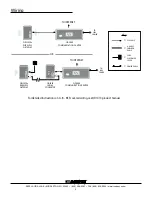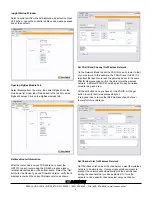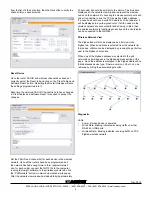
R
2800 LAURA LANE • MIDDLETON, WI 53562 • (800) 288-9383 • FAX (608) 836-9044 • www.tcsbasys.com
3
Setup & Troubleshooting
Throughout the setup document the terms coordinator, gateway
and QW1010c will be understood to mean the same thing. A
router is a TCS ZigBee wireless thermostat, bridge or repeater.
Location:
•
A wireless network will not function correctly if it is sepa-
rated by walls or other structures in which a wireless signal
cannot penetrate such as steel, concrete, or rocks.
•
The area containing wireless devices should be static/
non-changing, for example, do not place wireless devices
behind a steel door that is open during occupied times and
closed during unoccupied times.
•
No part of a wireless network should be placed outdoors.
The varying atmospheric conditions cause the wireless
signals to distort resulting in an unstable wireless network;
for example, a wireless network formed on a foggy day will
have trouble communicating on a clear day and vise versa.
•
The coordinator of the wireless network should be placed
at a central location with respect to the routers.
•
Coordinators and routers should be placed in an area with
little external wireless interference, away from other wire-
less devices.
Distance:
•
A wireless network will not function correctly if the distance
between the coordinator and/or routers exceeds approxi-
mately 150 feet line of sight. Walls or other barriers will
severely limit the maximum distance.
•
Wireless networks are only able to travel a maximum of 5
hops from the coordinator; routers placed beyond the 5 hop
limit will not join the network.
•
Routers are only able to have 6 children each.
Special Considerations:
•
A wireless network should be oriented in such a way that
routers are spread out equidistant in a circular pattern from
the coordinator so as to maximize the communicating area
available. Routers placed in a straight line may cause net-
work instability.
•
Subsystems and energy policies should never be placed on
a wireless network because a subsystem is dependent on
uninterrupted continuous communication.
•
Only 15 routers should be placed on a single wireless
network. A router is defined as a wireless thermostat,
bridge, or repeater. Large networks cause the wireless
communication to become unstable.
•
If multiple wireless networks are present, each net-
work must be given a separate Personal Area Network
Identification (PAN ID) wireless channel. Wireless channels
should be chosen in a way so as to limit interference from
other area neighboring channels, for example, instead of
using channels 11 and 12 use channels 11 and 25 or 11
and 14.
Wireless Deployment Overview:
All wireless thermostats are shipped with the H1 TCS ZigBee
Enable Jumper, located in the upper left of the base of the
thermostat, in the Off position. Wireless thermostats should be
powered up and given a TCS address prior to enabling the TCS
ZigBee Wireless module. See wireless thermostat instruction
manual for details.
For small networks with five or less thermostats, that is all that
is necessary is to enable wireless thermostats (place the H1
jumper on the left and middle posts). Power up the QW1010c
by plugging the USB cable into a laptop running Insight, into
a QD2040, or into the 120 VAC to 5 VDC USB power adapter
included with the QW1010c. Wait 15 to 20 minutes for the
wireless network to form. The wireless network should now be
usable.
For larger networks, or where multiple QW1010c are to be
used use the following procedure.
1. Power up the QW1010c by plugging the USB cable into a
laptop or PC running Insight software. Important: Do not
connect the QW1010c to the QD2040 at this time.
2. Using Insight, set the desired network Pan ID and
Channel on the Coordinator. Then click on Clear Tables
and Software Reset in the Reset tab. This will store the
new PanID and Channel. Then click on Reset Network in
the Reset tab. This will tell the QW1010c to form a new
wireless network.
3. Move the wireless thermostat to the installation location
and power it. Once it is addressed, move the H1 TCS
ZigBee Wireless Enable jumper to the Enable position
(middle and left post). The red LED should then be lit and
start blinking, thus indicating that the TCS ZigBee module
has power.
4. Connect a QD1010 to the wireless thermostat and to a
laptop running Insight.
5. Using Insight, set the same PanID and Channel that is
used on the QW1010c. Once these are set, click on Clear
Tables and Software Reset in the Reset tab. This will tell
the thermostat (router) to join a new network using this
PanID and Channel.
6. Repeat steps 3-5 for all the wireless thermostats / routers
on the network.
Wait about 3 minutes per wireless thermostat on the network
before connecting the QW1010c to a QD2040. The network
should now be usable. It can be verified with Insight if desired.
Note:
The baud rate for the QW1010c as well as all wireless
TCS products is 9600 baud.
Start Insight by clicking on the icon on the desktop or by going
to:
Start->All Programs-> TCS Basys Controls->Insight























